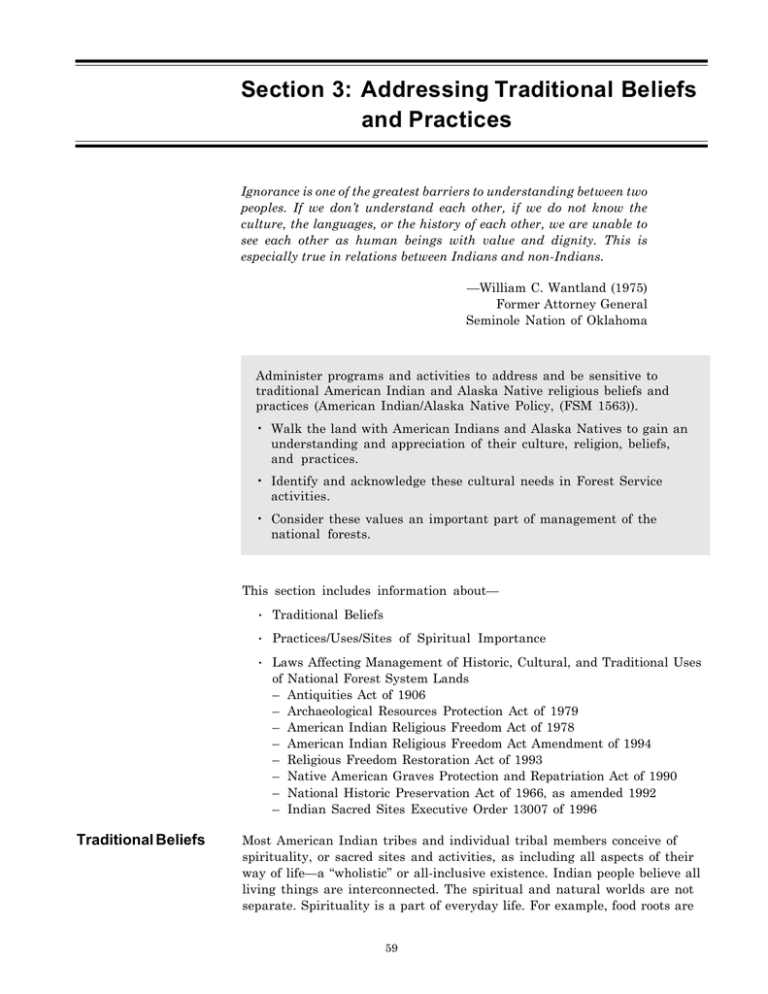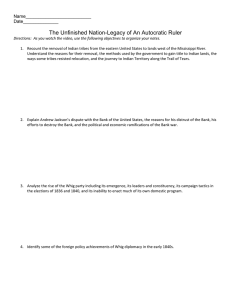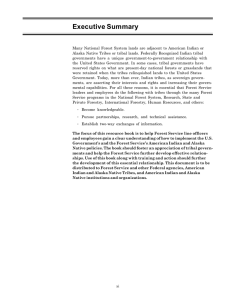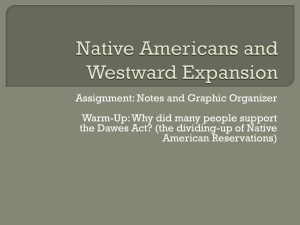Section 3: Addressing Traditional Beliefs and Practices
advertisement

Section 3: Addressing Traditional Beliefs and Practices Ignorance is one of the greatest barriers to understanding between two peoples. If we don’t understand each other, if we do not know the culture, the languages, or the history of each other, we are unable to see each other as human beings with value and dignity. This is especially true in relations between Indians and non-Indians. —William C. Wantland (1975) Former Attorney General Seminole Nation of Oklahoma Administer programs and activities to address and be sensitive to traditional American Indian and Alaska Native religious beliefs and practices (American Indian/Alaska Native Policy, (FSM 1563)). • Walk the land with American Indians and Alaska Natives to gain an understanding and appreciation of their culture, religion, beliefs, and practices. • Identify and acknowledge these cultural needs in Forest Service activities. • Consider these values an important part of management of the national forests. This section includes information about— Traditional Beliefs • Traditional Beliefs • Practices/Uses/Sites of Spiritual Importance • Laws Affecting Management of Historic, Cultural, and Traditional Uses of National Forest System Lands – Antiquities Act of 1906 – Archaeological Resources Protection Act of 1979 – American Indian Religious Freedom Act of 1978 – American Indian Religious Freedom Act Amendment of 1994 – Religious Freedom Restoration Act of 1993 – Native American Graves Protection and Repatriation Act of 1990 – National Historic Preservation Act of 1966, as amended 1992 – Indian Sacred Sites Executive Order 13007 of 1996 Most American Indian tribes and individual tribal members conceive of spirituality, or sacred sites and activities, as including all aspects of their way of life—a “wholistic” or all-inclusive existence. Indian people believe all living things are interconnected. The spiritual and natural worlds are not separate. Spirituality is a part of everyday life. For example, food roots are 59 not only necessary for subsistence, but also possess spiritual significance and serve ceremonial purposes. Therefore, gathering sites are not just subsistence sites, they may be traditional, cultural places. To Alaska Natives, subsistence represents the very core of their existence as a people. It is a spiritual, cultural, physical, and economic means to continue their heritage. It is the essence of their being. Celebrations, stories, songs, dance, and spirituality are derived from subsistence activities. These activities teach skills that determine the future success of younger tribal members as providers and productive members of the village and ensure the perpetuation of the culture for generations to come. Through subsistence activities, children learn respect for the wildlife and fish that present themselves for use. They also learn to share, respect, and provide for their elders, care for the land, and coexist with other human beings and cultures. The Alaskan experience clearly illustrates that where some non-Indian cultures may make a distinction between an economic or subsistence activity and a spiritual one, Indian people might consider both to have spiritual significance. This difference in world-views between Indian cultures and many non-Indian cultures is critical in this discussion, because laws that apply to traditional cultural properties may apply to many sites that some non-Indian cultures might not readily recognize as spiritual in nature, such as gathering sites. Practices/Uses/ Sites of Spiritual Importance Indian people determine what is of spiritual importance to them. It is the responsibility of the Forest Service line officer to consult with Indian people when Forest Service activities may affect spiritual or cultural practices, uses, sites, or areas. To gain accurate information about Indian cultural activities, it is best to— • Consult with traditional tribal members, spiritual practitioners, and elders. • During this consultation, keep in mind that the aboriginal territory of a tribe may extend beyond present reservation or Indian community boundaries. • Consult on a case-by-case basis and include treaty tribes and tribes with a legal, historic relationship to a geographical area now occupied by another group. A Forest Service line officer may have to decide among many land uses, all of which may have legitimate, but conflicting, interests in the same landscape. Forest Service leaders and managers must recognize and try to harmonize American Indian and Alaska Native cultural values as well as other management values that may occur on the same piece of land, and weigh potential impacts. Traditional practitioners may feel any use, other than ceremonial, will desecrate an area. Traditional use does not necessarily mean use which occurs in the same location today as it did in the past. Rather it means use 60 by Indian people in keeping with their traditional culture. Traditional practices may take place in nonaboriginal areas for tribes who were moved from their aboriginal territory or for individuals no longer living within their aboriginal territory. Some use the terms “contemporary sacred sites” and “traditional sacred sites” to differentiate between areas of historical use and those of current use. The key is that the activity is in keeping with the traditional culture. Line officers must consult with local tribes when they consider a request from a tribal group or individual to conduct traditional activities in nonaboriginal areas. Generally, tribes do not need permission or authorization to practice spiritual or cultural activities if a treaty reserves rights for such activities. However, special use authorizations or other types of agreements, such as Memorandums of Understanding or Agreement, may help formalize the responsibilities of both the tribe and the Forest Service. These agreements may: • Address resource conservation requirements or fire danger. • Assure that no conflicting uses occur during a tribe’s use of an area. A permit does not mean the Forest Service is granting permission for the activity, but rather that the Forest Service is documenting that the activity will occur and what safeguards are necessary for resource conservation and human safety. Information gathered during consultation with Indian people about the requested use(s) of the land will help shape the content, goals, and type of agreement needed. Take care to ask tribes or tribal members only those questions pertinent to the issue that necessitates an agreement, such as issues related to resource protection or safety and sanitation needs. In most cases, number of individuals and length of stay are the primary concerns. Asking specific questions about the nature of the ceremonies is usually unnecessary. Laws Affecting Management of Historic, Cultural, and Traditional Uses of National Forest System Lands Several general environmental statutes include provisions for managing significant cultural resources on National Forest System lands. The National Environmental Policy Act of 1969 (NEPA) and the Forest and Rangeland Renewable Resources Planning Act of 1974 (RPA), as amended by the National Forest Management Act of 1976 (NFMA), all address the need to identify, evaluate, and protect significant cultural sites and to consult with American Indian and Alaska Native peoples. (For more information on NEPA consultation, see Section Two.) In relation to cultural resources, these laws all draw upon the direction provided in the National Historic Preservation Act (NHPA) and provide the broad management context within which NHPA specifically addresses protection of cultural heritage. The following discussion summarizes the laws that affect cultural resources. These key points are by no means exhaustive; they are merely those that have the most direct bearing on management of traditional cultural sites and practices. 61 Antiquities Act The Antiquities Act of 1906 (P.L. 59–209)— • Provided penalties for the illegal removal, disturbance, or destruction of any object of antiquity on Federal lands. • Authorized the President to designate national monuments to protect historic and prehistoric structures and other objects of historic or scientific interest. • Stipulated that when such structures or objects are situated on land covered by an unperfected claim, or in private ownership, the land required to protect the structures or objects can be relinquished to the Federal Government. • Required permits for the examination, excavation, or gathering of objects of antiquity on Federal lands. The penalties provided under the Antiquities Act of $500 and/or 90 days in jail were so small as to be ineffective when large-scale looting and black market sales of Indian artifacts became apparent in the 1960’s. Subsequently, this act was replaced by the Archaeological Resources Protection Act (ARPA) to increase criminal penalties and to require permits for legal excavation and removal of objects of antiquity. However, the Antiquities Act is still used to designate national monuments. Archaeological Resources Protection Act (ARPA) The purpose of the Archaeological Resources Protection Act of 1979 (ARPA) (P.L. 96–96) (Implementing Regulations at 36 CFR 296) is “to secure, for the present and future benefit of the American people, the protection of archaeological resources and sites which are on public lands and Indian lands.” ARPA— • Sets felony-level penalties for destruction or theft of archeological resources and facilitates effective law enforcement. • Establishes a permit system and standards for institutions or individuals wishing to do archaeological research on Federal lands. • Requires the Regional Forester to notify any Indian tribe that may consider a site to have religious or cultural importance 30 days prior to issuance of the permit. This responsibility has been delegated to Forest Supervisors. • Stipulates that records and locations of archaeological sites and sensitive cultural properties are exempt from disclosure under the Freedom of Information Act (FOIA). ARPA permits on Indian reservation or trust lands require tribal council consent. For permits on National Forest System (NFS) lands, ARPA specifies only that tribal councils be notified. While tribal council consent is not necessary for permits on NFS lands, it is in the best interest of the Forest Service to reach resolution of tribal council objections to such permits. American Indian Religious Freedom Act (AIRFA) The American Indian Religious Freedom Act of 1978 (AIRFA) (P.L. 95–341) states that it is the policy of the United States “to protect and preserve for American Indians their inherent right of freedom to believe, express, and exercise the traditional religions of the American Indian, Eskimo, Aleut, and Native Hawaiians, including, but not limited to, access to sites, 62 use and possession of sacred objects, and the freedom to worship through ceremonials and traditional rites.” AIRFA is based on the fact that often, because of lack of knowledge, laws designed for “such worthwhile purposes as conservation and preservation of natural species and resources” result in the abridgment of religious freedom of American Indian and Alaska Native practitioners. Implementing regulations were never written for AIRFA and the well-known “G-O Road” case (Lyng v. Northwest Indian Cemetery Protective Assoc., 485 U.S. 439, April 19, 1988) set a precedent for its interpretation. The G-O Road case seemed to prove that AIRFA could do little to actually protect sacred sites, but it did reaffirm the responsibility of Federal agencies to insure that their policies and practices did not infringe on Indian religious freedom and that Federal agencies make a good faith effort to consult with Indian people about protecting sacred sites. The findings in the “G-O Road Case” were based on the fact that the Forest Service made considerable effort to mitigate the impacts of road construction on Indian spiritual practices. The court found that “[N]othing in our opinion should be read to encourage governmental insensitivity to the religious needs of any citizen. It is difficult to see how the Government could have been more solicitous. Such solicitude accords with the policy of the United States expressed in the American Indian Religious Freedom Act to protect and preserve the Indians’ access to sites, use and possession of sacred objects, and the freedom to worship through ceremonials and traditional rites.” While the G-O Road ruling was disappointing to tribes, it did emphasize the need for Federal agencies to make a good faith effort to protect traditional uses and sites. AIRFA does provide an avenue for sensitive responses to traditional use needs. The primary decisionmaking responsibility under AIRFA is with the involved Federal agency. AIRFA does not mandate access to public land for traditional use purposes nor does it mandate that Indian traditional use and spiritual concerns take precedence over other valid, competing uses. The avenues for tribes to resolve disagreements under AIRFA are the Forest Service’s internal appeal process and filing suit in Federal courts. Over the last 5 years, several bills have been proposed to strengthen AIRFA, but, to date, none have been signed into law. In 1994, the “American Indian Religious Freedom Act Amendment of 1994” was signed, but the title is misleading as it addresses only the use of peyote. American Indian Religious Freedom Act Amendment Commonly referred to as “the Peyote Bill,” the American Indian Religious Freedom Act Amendment of 1994 (P.L. 103–344) states that “Notwithstanding any other provision of law, the use, possession, or transportation of peyote by an Indian for bona fide traditional ceremonial purposes in connection with the practice of a traditional Indian religion is lawful, and shall not be prohibited by the United States or any State...” 63 This amendment also provides a definition of Indian Religion as “any religion which is practiced by Indians and the origin and interpretation of which is from within a traditional Indian culture or community...” Religious Freedom Restoration Act The Religious Freedom Restoration Act of 1993 (P.L. 103–141) statute mandates that the “government should not substantially burden the free exercise of religion without compelling justification.” The act further provides a claim or defense to persons whose religious exercise is substantially burdened by the government. Native American Graves Protection The Native American Graves Protection and Repatriation Act (NAGPRA) of 1990 (P.L. 101–601) (Implementing Regulations at 43 CFR 10) addresses the rights of lineal descendants and members of Indian tribes, Alaska Native, and Native Hawaiian organizations to retain certain human remains and precisely defined cultural items. It covers items currently in Federal repositories as well as future discoveries. NAGPRA requires Federal agencies to: and Repatriation Act (NAGPRA) • Prepare inventories of remains in their possession. • Consult with affiliated American Indian and Alaska Native tribal groups about the repatriation or treatment and disposition of these remains. • Establish a process for the return, upon request, of institutionally held skeletal remains, grave items, and other sacred objects to their groups of cultural affiliation. • Establish a process for the return of skeletal remains, grave items, and other sacred objects discovered during planned cultural resource inventory, evaluation, or excavation projects, as well as inadvertent discoveries. The Forest Service, having completed the necessary inventories and summaries of materials in its possession, will focus on ongoing consultation, new discoveries, and the continuing process of repatriation. National Historic Preservation Act (NHPA) The National Historic Preservation Act of 1966 (NHPA) (P.L. 89-665) (Implementing Regulations at 36 CFR 800 and 36 CFR 60) states that “the historical and cultural foundations of the Nation should be preserved as a living part of our community life and development in order to give a sense of orientation to the American people.” The 1992 amendments to NHPA strengthen requirements for cooperation between Federal agencies and American Indian tribes and Native Hawaiian Organizations. NHPA, as amended, and its implementing regulations in 36 CFR 800— • Establish the National Register of Historic Places and authorize regulations for State Historic Preservation Offices (SHPOs). • Designate a process to inventory, evaluate, protect, and interpret significant historic and archaeological sites. • Direct Federal agencies to consider the effects of their actions on significant cultural resources during all phases of planning and project implementation. A recent court decision (Pueblo of Sandia v. United States, 50 F.3d 856, 10th Cir. 1995) states that during consultation with tribes to determine effects of government actions on sites, the Forest 64 Service must make a good faith effort to elicit tribal concerns beyond just sending a letter to the tribe. • Direct the Federal Government to work in partnership with Indian tribes to provide leadership in the preservation of the prehistoric and historic resources of the United States. • Direct the Federal Government to assist Indian tribes and Native Hawaiian organizations to expand and accelerate their historic preservation programs and activities. • If the tribe meets the guidelines and responsibilities of that office as specified by the act, authorize tribes to assume the role of historic preservation officer on tribal land. • Strengthen the Federal agencies’ ability to maintain the confidentiality of sensitive material by giving them the authority to withhold sensitive locational or cultural information from public disclosure if that disclosure may— – Cause a significant invasion of privacy. – Risk harm to the historic resources. – Impede the use of a traditional religious site by practitioners. Unlike ARPA, the Forest Service cannot unilaterally withhold documents it thinks are confidential. It must consult with the Keeper and the Council on such withholdings (Section 306 of NHPA; 16 U.S.C. 470w-3). The 1992 amendments say that “properties of traditional religious and cultural importance to an Indian tribe or Native Hawaiian organization may be determined to be eligible for inclusion on the National Register.” There has been considerable debate over this point. National Park Service Bulletin 38, “Guidelines for the Evaluation and Documentation of Traditional Cultural Properties” states “the National Register is not the appropriate vehicle for recognizing cultural values that are purely intangible, nor is there legal authority to address them under Section 106 of NHPA unless they are somehow related to a historic property.” Internal Forest Service direction, (USDA Forest Service, Chief’s Office 1991—Appendix A) amplifies this view: “A property may be eligible to the National Register of Historic Places and may have traditional values associated with it, but traditional values do not make an area eligible unless they are directly associated with a historic property.” When deciding whether to address a traditional cultural property concern under NHPA or AIRFA, keep in mind that properties determined to be eligible for the National Register through the NHPA consultation process are not guaranteed protection. NHPA is a procedural law, directing the Forest Service to mitigate adverse effects to significant properties. Since effects to spiritual values and sacred sites are often “not mitigatable,” NHPA may not offer the kind of protection often sought for these types of sites. Indian Sacred Sites— Executive Order 13007 On May 24, 1996, President Clinton signed Executive Order 13007, titled “Indian Sacred Sites.” This executive order directs Federal agencies “to the extent practicable permitted by law and not clearly inconsistent with essential agency functions to:” 65 • Accommodate access to and ceremonial use of Indian sacred sites by Indian religious practitioners. • Avoid adversely affecting the physical integrity of such sites to the extent practicable. • Maintain the confidentiality of sacred sites. • Submit a report to the President on May 24, 1997, listing any changes necessary to accommodate access and use of sacred sites, changes in procedures implemented or proposed to facilitate consultation with Indian tribes and religious leaders relative to this order as sacred by virtue of its established religious significance to, or ceremonial use by an Indian religion. A sacred site is defined as being “any specific, discrete, narrowly delineated location on Federal land, identified by an Indian tribe or Indian individual determined to be an appropriately authoritative representative of an Indian religion, as sacred by virtue of its established religious significance to, or ceremonial use by, an Indian religion, provided that the tribe or individual has informed the agency of the existence of such a site.” EO 13007 addresses only Federally Recognized Tribes and does not affect efforts to protect sites important to non-Federally Recognized Tribes. The order is not intended to create any additional right, benefit, or trust responsibility. Currently, the Forest Service is working with other Federal agencies to develop implementation procedures for EO 13007. A copy of this executive order may be found in Appendix A. Summary The laws, regulations, and policies described here emphasize the importance of American Indian/Alaska Native involvement at the earliest possible planning stages and provide a framework for consultation. The Forest Service retains the responsibility to make the final decision, taking into consideration all of the information learned through the consultation processes. These statutes promote open dialog, possible solutions, compromise, and most importantly, a climate in which tribal governments and the Forest Service can work together to protect resources and values. 66




